Acne is a multifaceted skin condition that is almost every teenager’s nightmare! According to the American Academy of Dermatology (AAD), it is a chronic inflammatory skin disease that is characterized by pimples, lumps, blackheads and whiteheads that occur on the face, neck, shoulders, upper arms, chest and back. It usually starts at puberty and affects many young adults, though it can occur at any stage in life. Research indicates that it affects up to 50 million Americans annually.
Acne results from excess production of sebum that combines with skin cells, clogging pores and causing bacteria to multiply and lesions to occur. In almost all skin afflictions, there is a connection to underlying internal disbalances. The following factors have been linked to acne:
Liver health
Hormonal imbalance/toxins
Diet
Stress
Genetics/hereditary
The Site may contain links to affiliate websites, and we receive an affiliate commission for any purchases made by you on the affiliate website using such links. We are highly selective with what products we recommend. Our affiliates include ShareASale and Banyan Botanicals.

According to many schools of traditional medicine, such as Classical Chinese Medicine and Ayurveda, the main organ associated with skin health is liver. The liver performs vital digestive, hormonal and detoxification tasks. It is the body’s major detoxification system that expels toxins and excess hormones from the body. It is crucial to reduce the load of toxic metabolites and toxins accumulated in the liver tissues, and thus enhance its power of detoxification. Because the skin is an organ of elimination (and is the largest due to its surface area), everything that doesn’t get detoxified and eliminated by the liver/kidneys/intestines will be directed toward the skin.
Toxins are now ubiquitous in our environment, and get into our food, water and air. In addition, our internal environments are not suited to detox optimally with increasing levels of stress, less sleep and less nutrients in our diet. The liver is unable to handle all the elimination necessary for a healthy body.
A study conducted by Panzer et al. has revealed that oral contraceptives can cause an imbalance of minerals and vitamins and are associated with high levels of copper. They also increase the sex hormone binding globulin SHBG that may continue long after discontinuation of the pill. Xenoestrogens (estrogens from outside the body) and phthalates and poor excretion of estrogen can also contribute to elevated SHBG and potentially result in “estrogen dominance.”
The body is always trying to rid itself of toxins. If the liver, kidneys and lungs do not perform this role efficiently, the body needs help from the skin. It evacuates the waste products as crystals, which are residues of metabolism that may flare up the skin and cause rashes. In the case of acne, excess production of sebum combines with skin cells, hence clogging pores causing bacteria to multiply and lesions to fester.
A liver supportive protocol is essential to prevent a toxic overload and it is also beneficial for general wellbeing.
Eliminate processed foods, hydrogenated oils, refined sugars and meats from diet.
Eat more vegetables and juice liver cleansing vegetables like cabbage, cauliflower, milk thistle and brussel sprouts. Carrots cucumbers, beets and greens can also be added. Carrot, orange, ginger juice also works very well as a liver cleanse because of the beta-carotene content.
High potassium foods are also essential in cleansing the liver; these include bananas, beets, sweet potatoes and beans. They also lower cholesterol and blood pressure.
Herbs like dandelion (root), milk thistle (seed), turmeric (rhizome), schisandra (berry), white peony (root), angelica (or dong quai, root) can be incorporated.
Drink lots of water!
Nutrients
Food is such an important aspect to having a healthy body. Yet the quality of food diminishes, and our soil is unable to produce vital produce anymore. Even people who are ‘health-conscious’ and eat unprocessed foods, they are not getting enough vitamins and minerals to support healthy bodily functions and adequate detoxification pathways. The following vitamins and minerals play a great role in maintaining liver, skin and eye health, which are all connected. Since we are not getting enough in food, supplementation may be recommended.
Antioxidants: flavonoids, anthocyanins, carotenoids, lycopene → found in berries, fruits and vegetables, especially rich in blue/orange/red pigmented ones
Sulfur for GSH (glutathione production) → found in amino acids (methionine, cysteine, homocysteine, taurine) and vegetables in brassica family
Vitamins: A, D, E, K → fat soluble vitamins found in cod liver oil
Vitamin C: necessary for collagen production and wound healing → from citrus fruit, amla berry
Minerals: Calcium, Zinc, Magnesium → mineral rich herbs such as horsetail, nettles, alfalfa; rice and grains (soak with apple cider vinegar first); epsom salt; pumpkin seeds are a good source of zinc
Trace minerals: Selenium → brazil nuts
Glycemic index
A study published in the Journal of the Academy of Nutrition and Dietetics has established a direct correlation between diet and acne, specifically from high glycemic load diets and dairy products. It has given evidence that medical nutrition therapy can play a significant role in the treatment of this condition. Foods with a high glycemic index, hormones and growth factors in milk have been proven to cause and aggravate acne.
National Center for Biotechnology Information (NCBI) research has confirmed that high glycemic index foods contribute to high spikes in blood glucose levels, which in turn cause insulin disruption and eventual downregulaton, leading to diabetes (type 2). These foods include the following: white bread, potatoes, pasta, breakfast cereals, white rice, macaroni, crackers, fruit (especially dried and tropical, as well as grape). According to their study, people with acne who adopted a low glycemic index diet had skin improvements; patients with polycystic ovarian syndrome, which often has acne as one of its symptoms, who were prescribed drugs for sugar control also improved in symptoms.
Gut integrity
According to the University of Maryland Medical Center, citrus foods may trigger acne for those allergic to them. Another group of problem foods are gluten (a type of large protein containing the amino acid prolamine) found in grains like wheat, barley and rye. The sticky-like proteins in gluten have a tendency to make the gut more permeable, allowing partially digested proteins into the bloodstream causing the immune system to be sensitized promoting inflammation therefore aggravating acne.
An elimination diet can be adopted to determine what the cause of acne may be. It is basically an eating plan where one eliminates suspect foods and observes if there is any improvement. The foods can also be re-introduced (after a period of at least 21 days of elimination) to determine which foods are problematic. In the case of acne, the following food groups are common suspects and eligible for an elimination protocol: dairy, gluten, sweets/sugar, eggs, chocolate, legumes and soy. One can also eliminate all suspect foods and re-introduce them one at a time to see which ones cause reactions. Most elimination diets take 3-6 weeks, so that the antibodies can dissipate and for one to fully heal from sensitivity.
A great natural way to heal your gut lining is to consume foods and herbs that will coat the endothelial walls and help wound repair there. The following nutrients help heal damage and build collagen in your gut and skin:
Gelatin and collagen-rich foods, such as bone broth, repair the structure of endothelium (note that this is an animal product and is not vegetarian/vegan). See my recipe for bone broth here.
L-glutamine is an amino acid vital for building and repairing lining of gut, helpful in leaky gut and ulcers. It’s found in foods like bone broth, beef, spirulina, chinese cabbage, cottage cheese, asparagus, broccoli rabe, wild caught fish, venison and turkey; or it can be taken in supplement form (vegan options!)
Vitamin C is a precursor to collagen providing protection to the gut, and structure and elasticity to skin
Demulcent herbs such as marshmallow root, hibiscus, and slippery elm help coat the walls of the gut and heal the tissue, blocking internal absorption of offending molecules
Stress can be the cause of a range of conditions including acne, hair loss and sleeping disorders. According to Dr. Anne Chapas of Union Square Laser Dermatology, stress causes acne by raising cortisol levels which works on the testosterone pathway therefore aggravating acne. A study conducted by Alexa Kimble of Stanford University on college students concluded that their acne is at its worst during the exam period. People under stress may not be eating well or getting enough sleep and insomnia causes high cortisol levels associated with acne.
Reducing stress levels, eating right and getting enough sleep have been suggested as ways of minimizing breakouts. Relaxation is essential in managing a variety of health conditions and the following are suggested methods:
Autogenic training: One focuses on the physical sensation of their own breathing or heartbeat and pictures their body as warm, heavy, and/or relaxed.
Biofeedback: Uses electronic devices to teach you how to consciously produce the relaxation response.
Deep breathing or breathing exercises: You consciously slow your breathing and focus on taking regular and deep breaths.
Guided imagery: One focuses on pleasant images to replace negative or stressful feelings to relax. May be directed by a practitioner through storytelling or descriptions designed to suggest mental images.
Progressive relaxation: For this relaxation method, you focus on tightening and relaxing each muscle group. Often combined with guided imagery and breathing exercises.
Self-Hypnosis: One produces the relaxation response with a phrase or nonverbal cue or suggestion
Although this factor is not modifiable, the good news is that it is manageable with all the things mentioned in this article. Your genes may predispose you to skin eruptions, but epigenetics plays a bigger role – and you will be able to turn genes ‘on’ or ‘off’ by choices in diet and lifestyle. Some people are just lucky and can eat all they want, live an incredibly stressful life, have all kinds of vices and have picture-perfect skin. However, for most of us, several generations of similar stressors to our parents and grandparents have taken a toll even into our genome. Instead of inheriting protective telomeres that would allow us to engage in more risky indulgences, lack of such a safety net results in us exhibiting symptoms on our skin. Because we have biological predisposition for more inflammatory afflictions, we must be extra vigilant in our self-care, diet and stress levels. Doing the practices outlined here will help your skin become as radiant as your genetic code allows for (i.e. very!).
Conventional Treatment
Conventional medicine prescribed by dermatologists works by controlling bacteria and inflammation, balancing hormones, minimizing oil production and preventing abnormal clumping of cells in follicles claims to treat acne effectively. However, research and empirical experience has proven that chemicals used in oral and topical medications have adverse side effects and don’t eliminate the root cause of the problem. This means the problem will appear again and again if treatment is stopped, and becomes an endless game of cat and mouse.
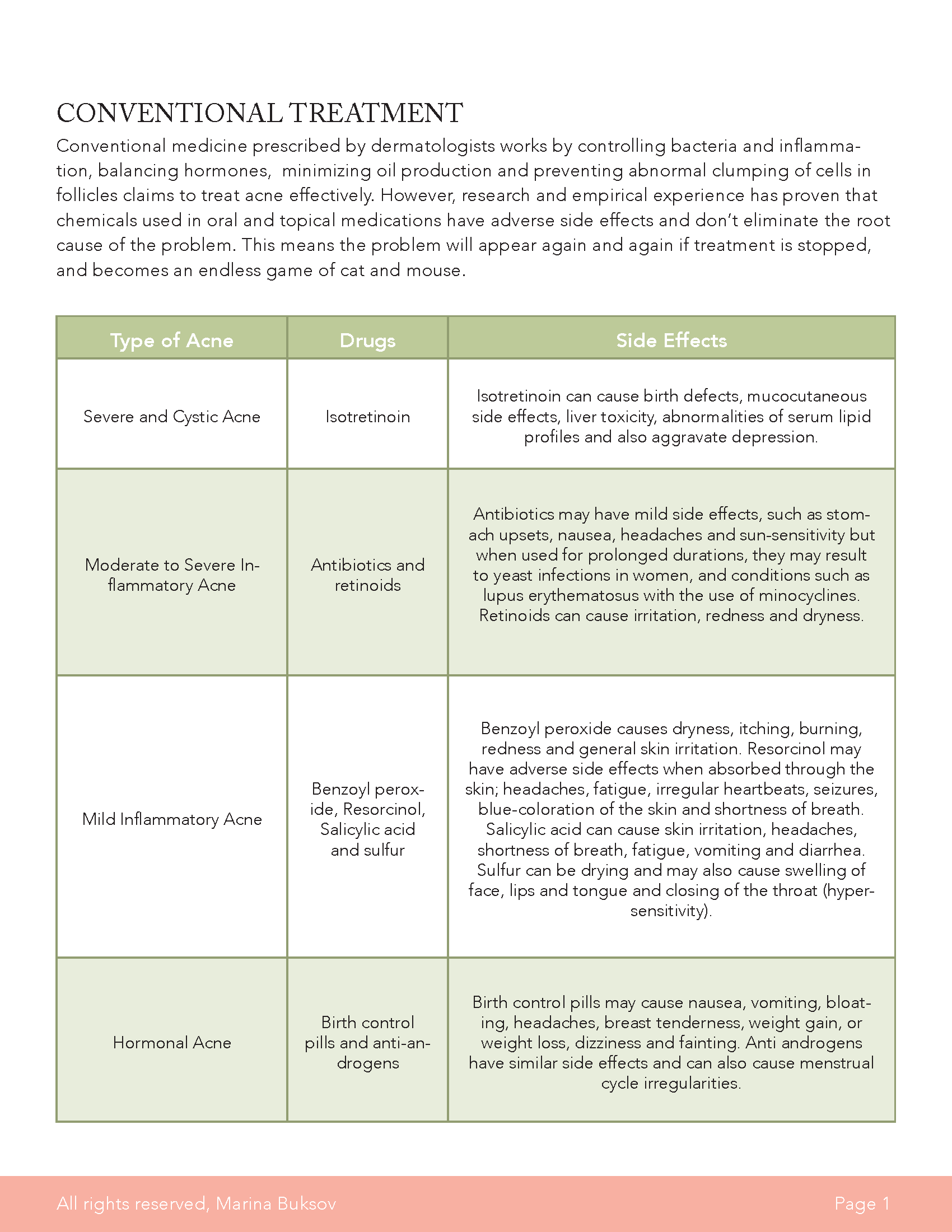
HOMEOPATHIC REMEDIES
The National Center for Homeopathy recommends the following as effective homeopathic treatments for acne:
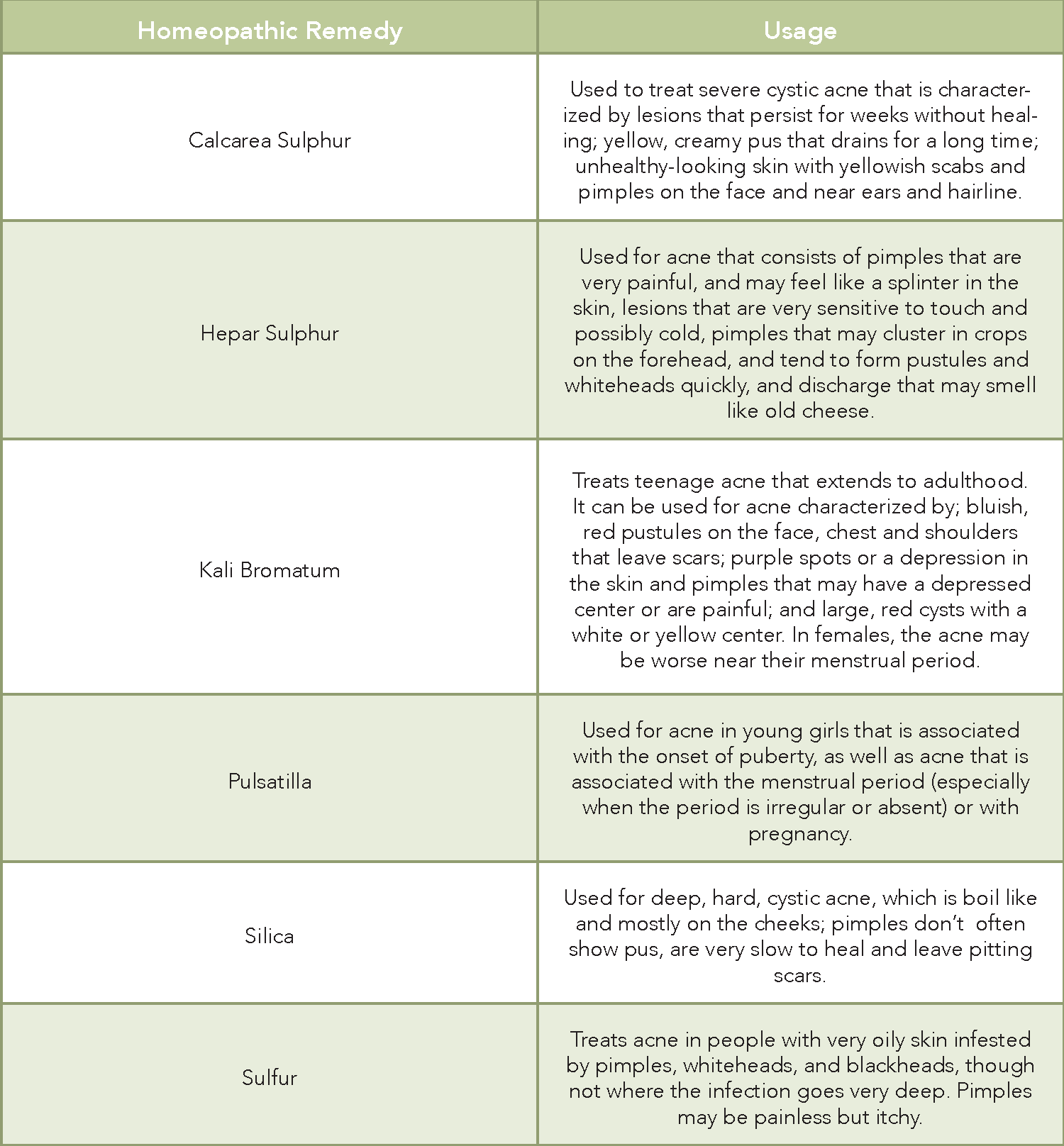
HERBAL TREATMENT
Herbal remedies have been used for centuries to treat various types of ailments. A study by Herbal Treatment for Dermatologic Disorders has proven that herbal remedies have shown efficacy in the treatment of different skin disorders including acne (Shenefelt, 2011). They are in fact considered safe compared to conventional medicine since they do not have adverse side effects and do not interfere with normal bodily functions when used properly. They have been shown to be beneficial as both oral drinks (infusions/teas/decoctions) and topical applications (wash, toner, oil, cream, salve). The following is a non-comprehensive table of select herbs commonly used for skin conditions.
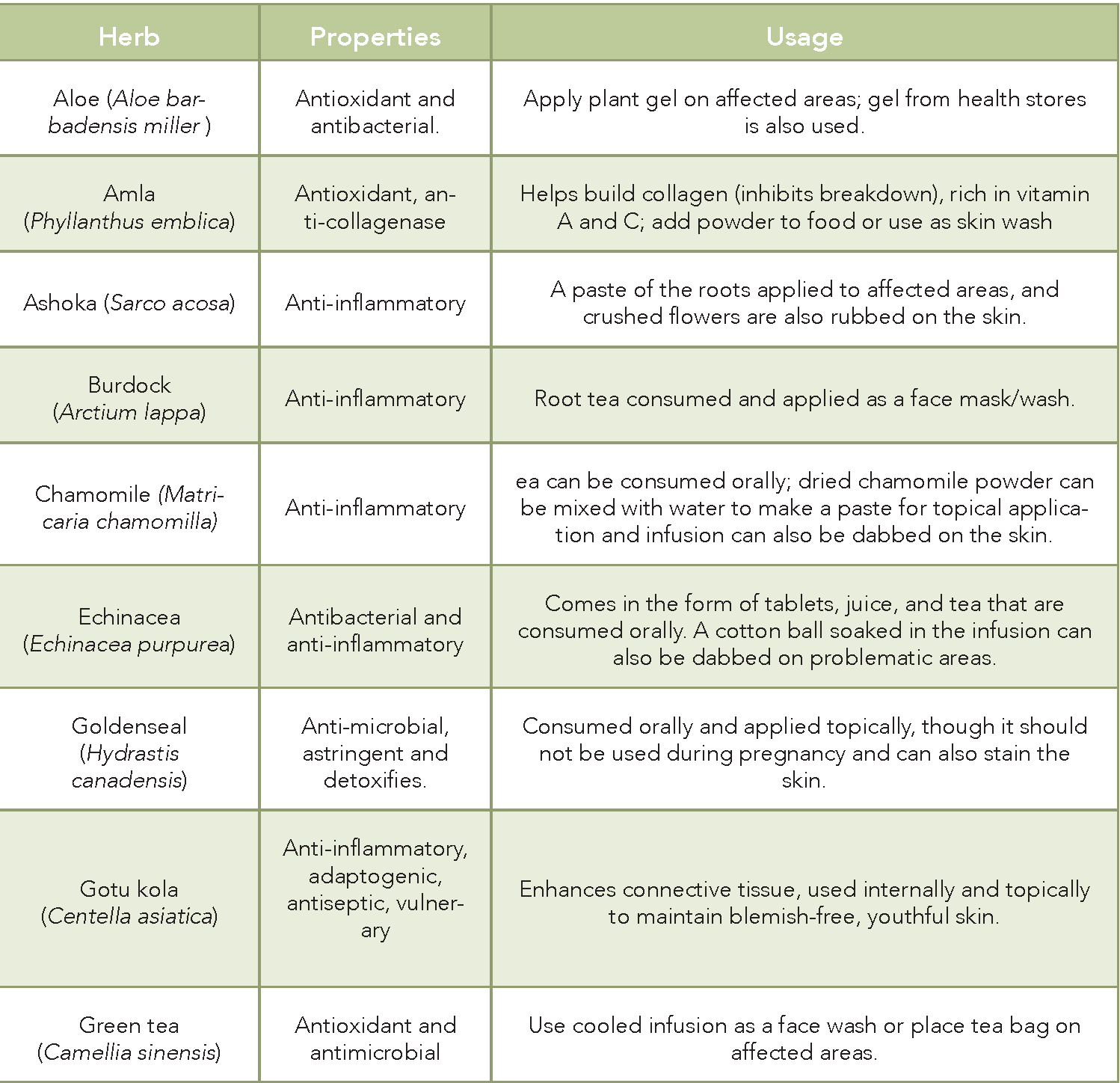
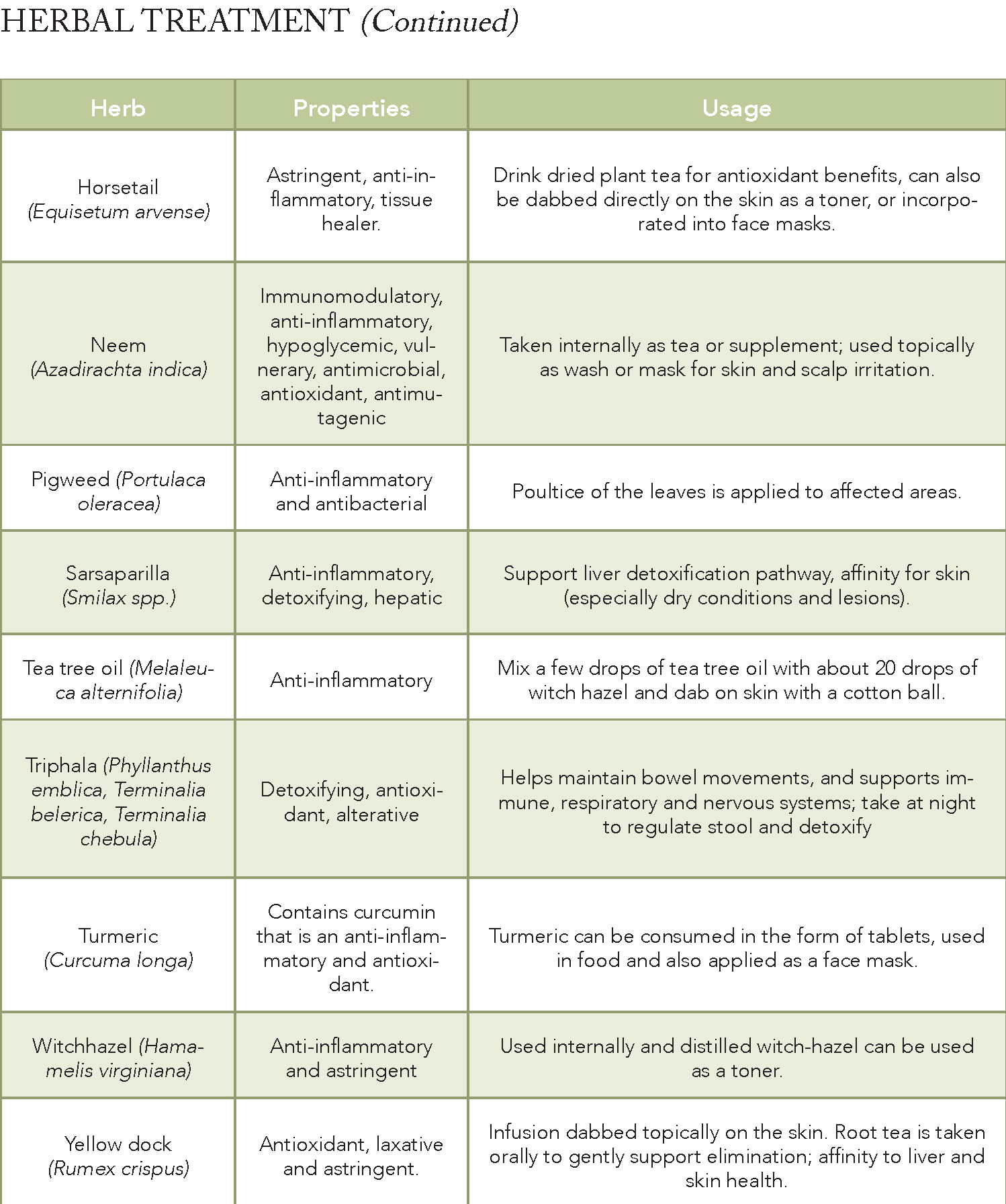
HORMONE BALANCE
Several studies have confirmed that natural remedies are effective in the balancing of female hormones (Grant and Ramasamy 497-502). Below is a table with some of these herbs and their properties.
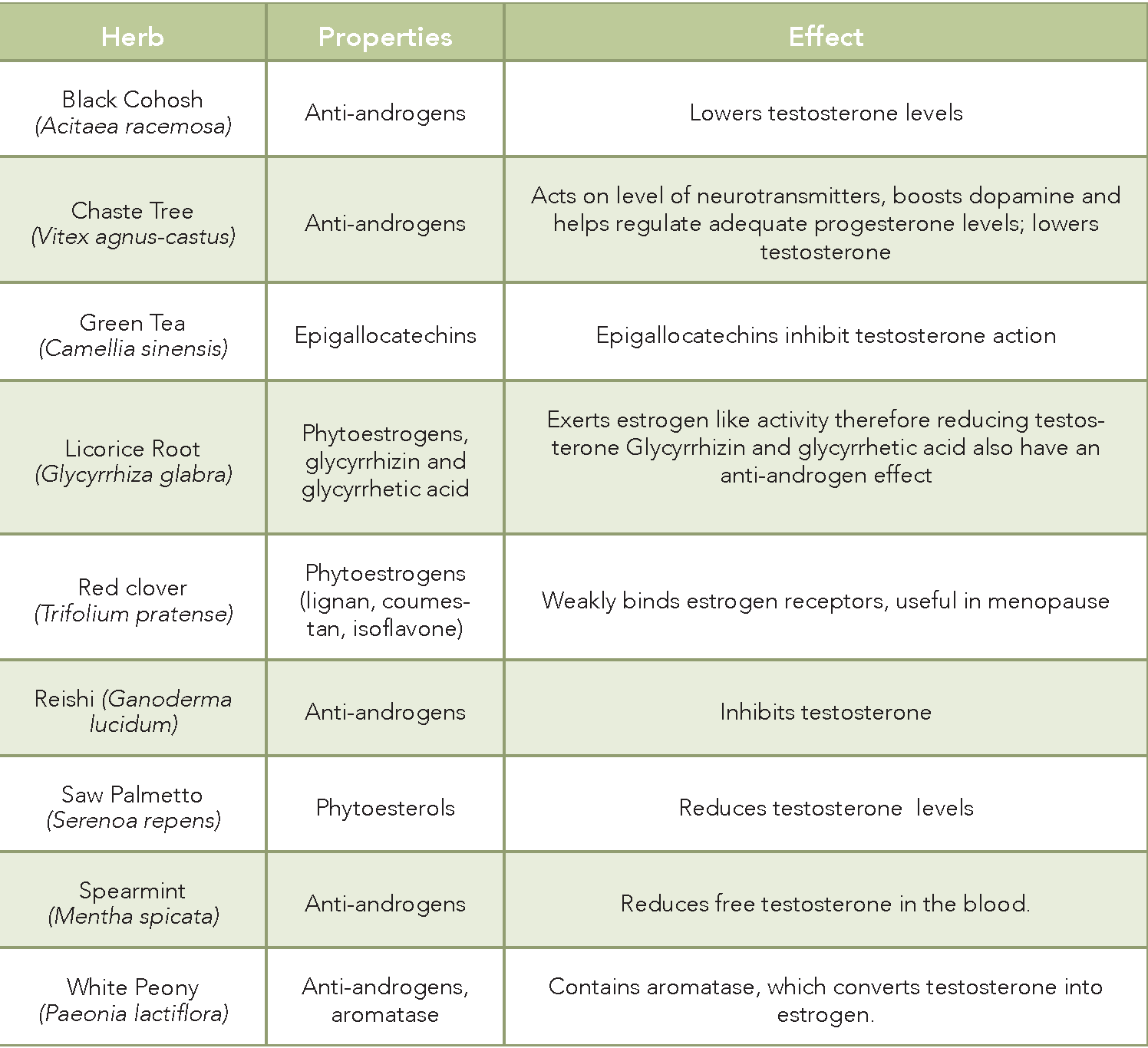
NATURAL TOPICAL CARE
And finally, certain natural oils consumed orally or applied topically can be used to constitute a healthy skin care regimen. Some are highlighted in the table below. According to Zu et al. (3200-3210) ten essential oils have proven to be effective against propionibacterium acnes.
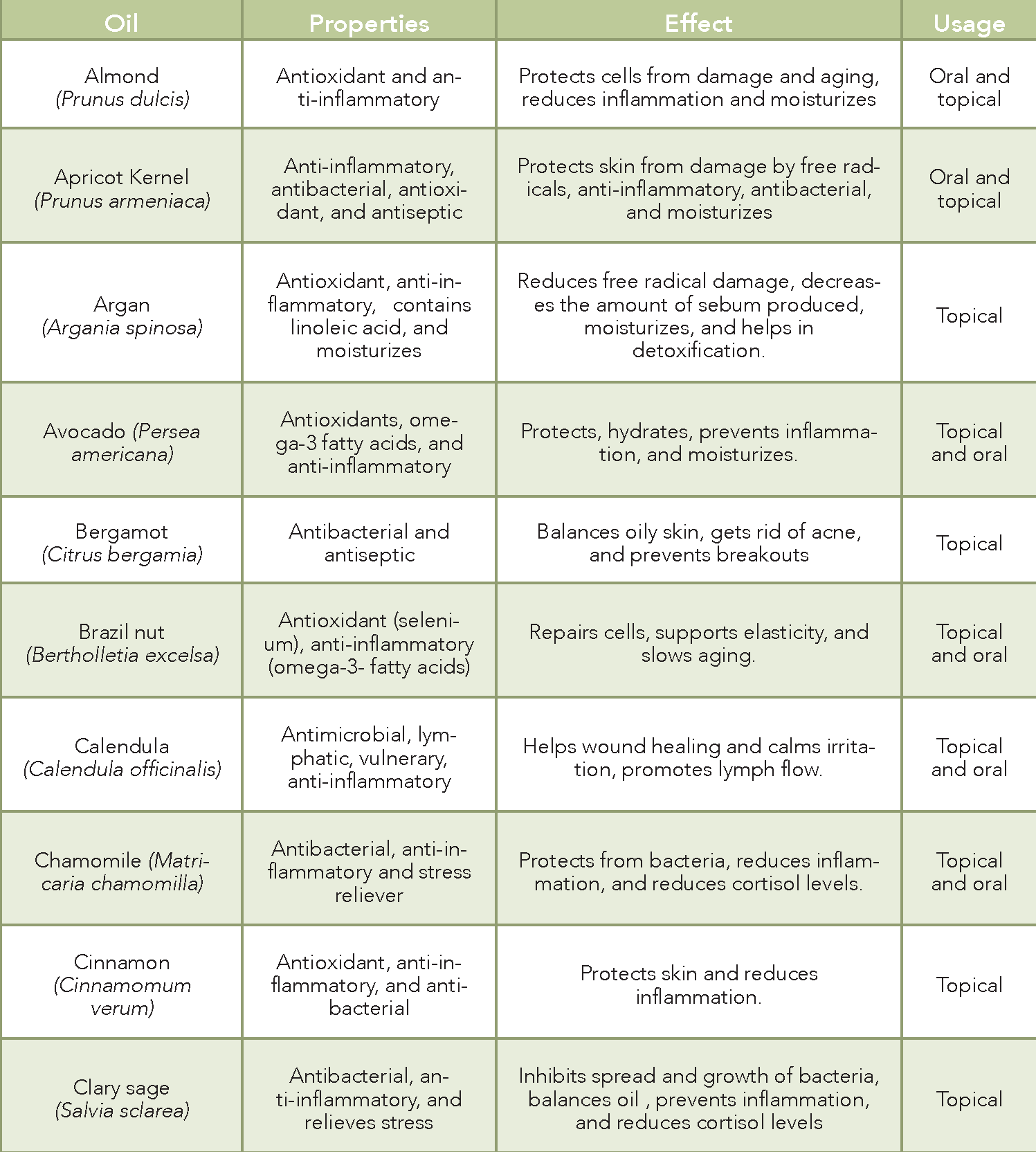
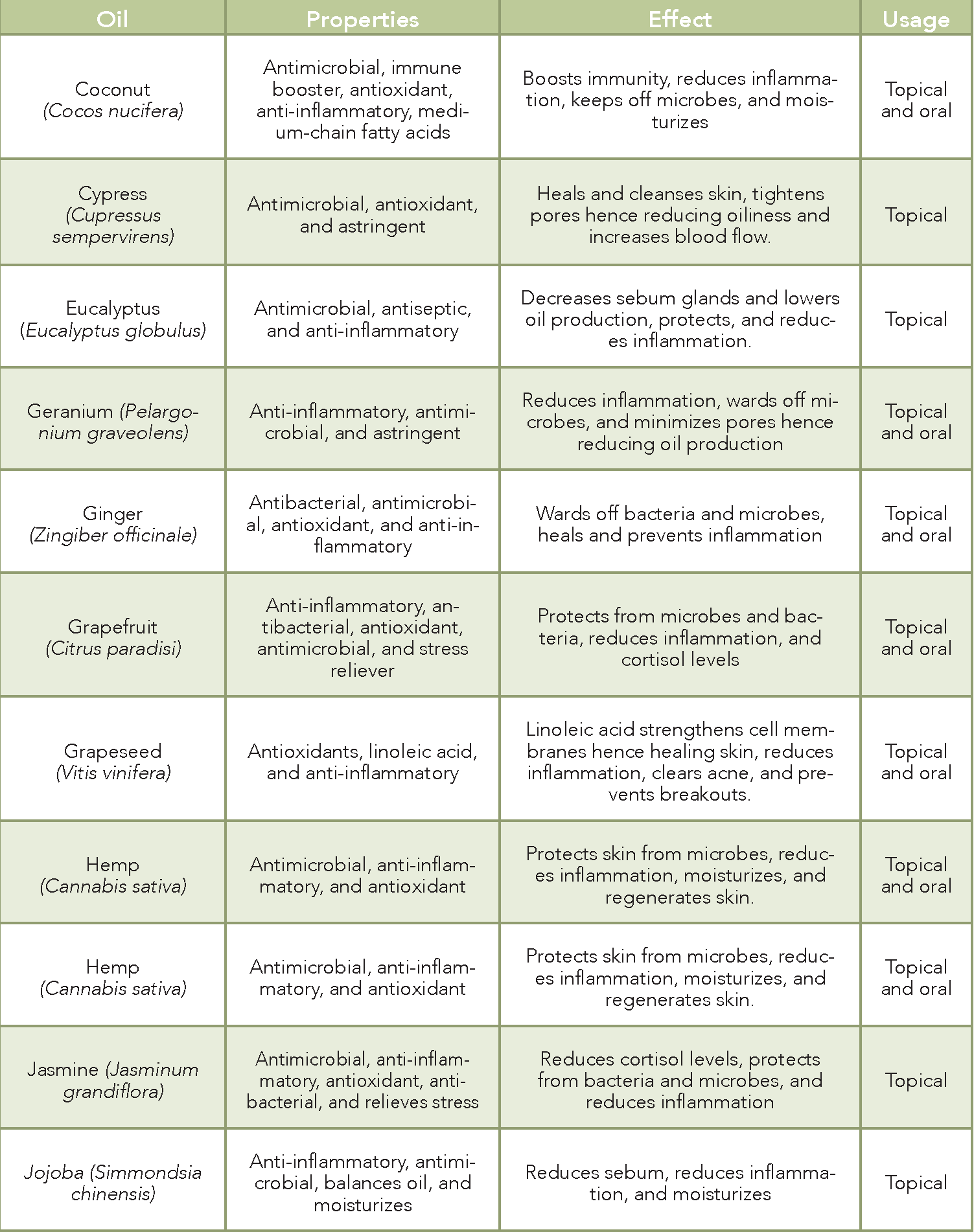
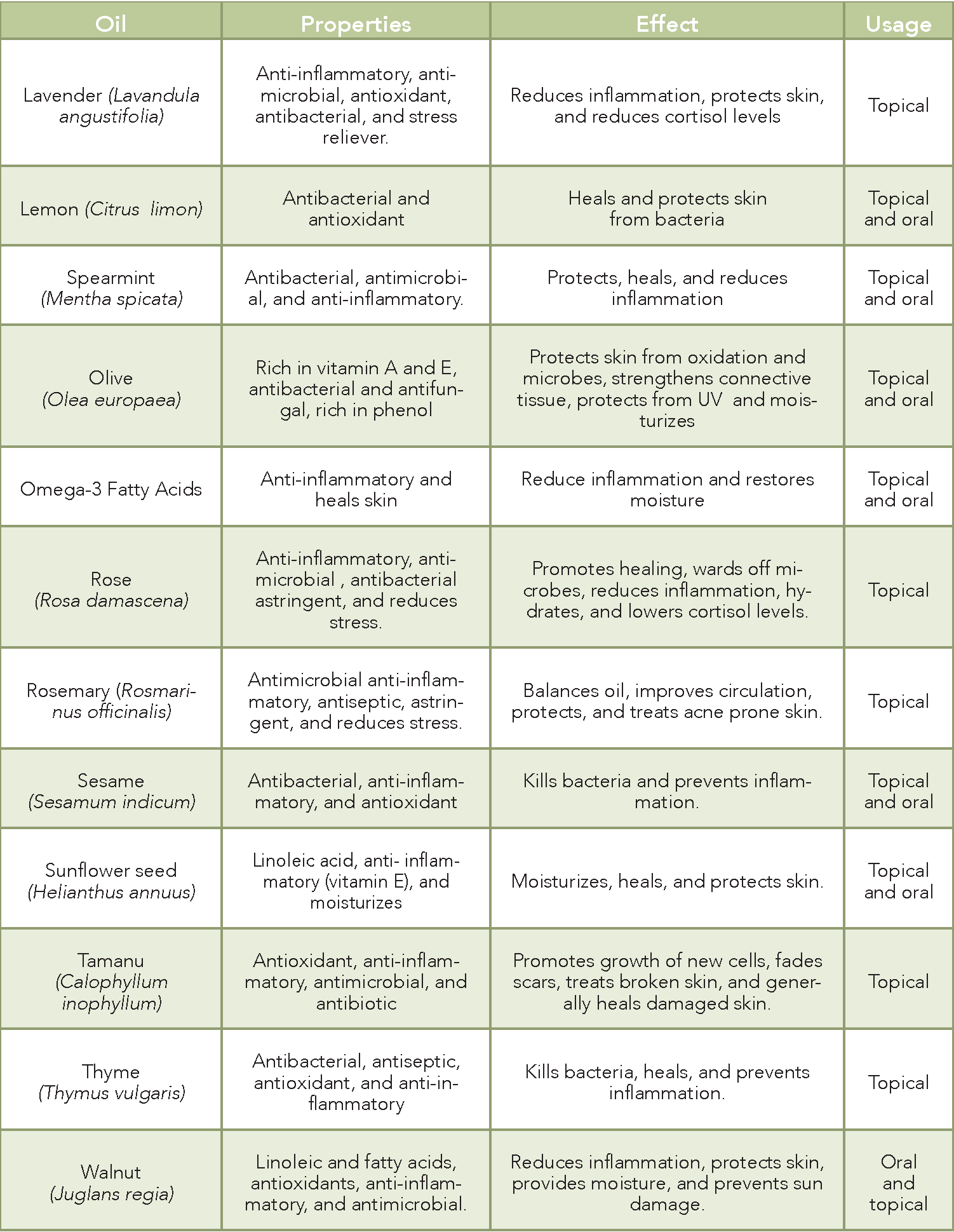
Back acne forms the same way as facial acne, i.e hormones, stress, diet and lifestyle choices, or it may be more closely related to acne mechanica (caused by contact with clothes or other objects). With the pores at the back being larger therefore producing more oil, back and body acne may turn into inflammatory acne more often than facial acne does. Wearing loose-fitting clothing made from natural fabrics and cleansing the skin regularly may help with this condition. Jojoba oil application may be helpful, as it mimics the consistency of sebum and may help regulate the skin’s oil secretion.
PROPER HYGIENE
Washing face twice daily with a mild cleansing agent removes dirt and excess oil. Rinse with warm, not hot water and pat dry with a clean towel.
Avoid scrubbing the face as this can cause irritation and spread bacteria around which can settle in the deeper layers exposed by the irritation.
Pillowcases should be changed regularly to prevent the transfer of oils and bacteria to your face.
Remove make-up every night before bed to allow the skin to breathe and rejuvenate.
Keep long hair tied back in order to help stop the transfer of hair oils onto the face
Try to avoid touching the face with hands because they harbor millions of bacteria due to the tasks they perform, and these bacteria can transferred to the skin causing infections
Avoid stress, which increases cortisol levels that lead to production of excess sebum.
Natural products can also be used as part of a healthy skin care regimen; This includes Pine Tar Soap commonly known for its antiseptic, antimicrobial and anti-inflammatory properties. It has been proven effective for a wide range of skin conditions.
According to Dr. David E. Bank founder of The Center for Dermatology, Cosmetic and Laser Surgery pillowcases can transfer dirt and oil to your skin and are a common cause of acne mechanica that results from contact with objects and materials. Build up of dirt and oil on your pillowcase is transferred to the skin and can clog pores and cause breakouts. Though natural fabrics are preferable for pillowcases he argues that the material doesn’t matter and as long as it is not changed regularly and laundered properly it will accumulate oil, grime and sweat that will be transferred to the skin and eventually cause skin problems. Bleached or dyed pillowcases are also not appropriate for those with sensitive skins. Though not everyone will breakout from a pillowcase they can exacerbate acne through micro-irritation.
Oil Cleansing Method
Oiling an acne infested skin may seem strange, but oils actually help support the skin’s own oil regulation. Unlike harsh, chemical-laden washes and scrubs commonly seen at pharmacies and heavily advertised, they don’t strip skin of its natural layer of moisture and oils. In this way cleansing products actually cause the skin to produce a lot of sebum to re-balance. On the contrary, oils help balance the skin’s natural oil production as well as hydrate and maintain an optimal pH balance.
Commonly used oils are jojoba, olive, castor, coconut, sweet almond, and argan. Most of these oils are antimicrobial, anti-inflammatory and have antioxidants therefore protecting the skin from microbes, free radicals that cause premature aging and reduce or prevent inflammation. Dr. Diane Walder, a cosmetic dermatologist, says that these oils work by binding impurities on the skin and pulling dirt from pores, and when rinsed away they leave the skin clean, soft and hydrated.
One can use a blend of oils depending on what works for them, for example, a blend of 70% sunflower seed oil and 30% castor oil works for oily skin. (If skin feels too dry use less castor oil). Castor oil cleanses while sunflower oil dilutes the castor oil and also provides nutrients and moisture. Drier skin require heavier oils that will hydrate all day, but acne prone skin which is usually oily needs oil that is light in consistency like almond, coconut and argan.
See the method I use here, and watch as your skin complexion improves!
Works Cited
“Acne.” American Academy of Dermatology. N.p., n.d. Web. 16 Aug. 2016.
Boyera N, Galey I, Bernard BA.Effect of vitamin C and its derivatives on collagen synthesis and cross-linking by normal human fibroblasts. Int J Cosmet Sci. 1998 Jun;20(3):151-8. doi: 10.1046/j.1467-2494.1998.171747 PMID: 18505499
Burris, Jennifer, William Rietkerk, and Kathleen Woolf. “Acne: The Role of Medical Nutrition Therapy.” Journal of the Academy of Nutrition and Dietetics 113.3 (2013): 416–430.
Cordain L, Lindeberg S, Hurtado M, et al . Acne vulgaris: a disease of Western civilization. Arch Dermatol 2002; 138:1584–1590.
Grant, Paul, and Shamin Ramasamy. “An Update on Plant Derived Anti-Androgens.” International Journal of Endocrinology and Metabolism 10.2 (2012): 497–502.
El-Akawi Z, Nemr NA, Abdul-Razzak K, et al . Factors believed by Jordanian acne patients to affect their acne condition.East Medit Health J 2006; 12: 840–846.
“L-glutamine benefits leaky gut & metabolism.” Dr. Axe: Food is Medicine. https://draxe.com/l-glutamine-benefits-side-effects-dosage/
Panzer, Claudia, et al. “ORIGINAL RESEARCH—WOMEN’s SEXUAL DYSFUNCTION: Impact of Oral Contraceptives on Sex Hormone‐Binding Globulin and Androgen Levels: A Retrospective Study in Women with Sexual Dysfunction.” The Journal of Sexual Medicine 3.1 (2006): 104–113.
Pick, Marcell. Phytotherapy – The key to hormonal balance? Women to Women. Yarmouth, Maine, 2017. https://www.womentowomen.com/hormonal-health/phytotherapy-the-key-to-hormonal-balance/
Pientaweeratch S, Panapisal V, Tansirikongkol A. Antioxidant, anti-collagenase and anti-elastase activities of Phyllanthus emblica, Manilkara zapota and silymarin: an in vitro comparative study for anti-aging applications. Pharm Biol. 2016 Sep;54(9):1865-72. doi: 10.3109/13880209.2015.1133658. Epub 2016 Feb 24. PMID: 26912420
Philip D. Shenefelt. 2011. “Herbal Treatment for Dermatologic Disorders.” Herbal Medicine: Biomolecular and Clinical Aspects
Reynolds, Rebecca C., et al. “Effect of the Glycemic Index of Carbohydrates on Acne Vulgaris.”Nutrients 2.10 (2010): 1060–1072.
“Smilax-Smilax aspera.” Healthbenefits.com. https://www.healthbenefitstimes.com/smilax/
Subapriva R, Nagini S. “Medicinal properties of neem leaves: a review.” Curr Med Chem Anticancer Agents. 2005 Mar;5(2):149-6. PMID: 15777222.
Varma SR, Sivaprakasam TO, Mishra A, et al. Protective Effects of Triphala on Dermal Fibroblasts and Human Keratinocytes. PLoS One. 2016 Jan 5;11(1):e0145921. doi: 10.1371/journal.pone.PMID: 0145921. eCollection 2016.
Sitemap © 2023 Marina Buksov, LLC. All Rights Reserved
*Disclaimer*: The statements made herein have not been evaluated by Food and Drug Administration. Any/All products listed are not intended to diagnose, treat, cure, or prevent any diseases. The Site may contain links to affiliate websites, and we receive an affiliate commission for any purchases made by you on the affiliate website using such links.
View our full disclaimer here, and terms & conditions here. View our Privacy Policy here.